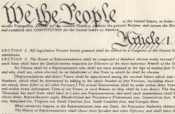| Part of the series on |
| U.S. Discrimination Law |

|
| Standards of Review |
| Other Legal Theories |
| Defining Moments in Law |
|
The 14th Amendment |
| Modalities of Constitutional Law |
VMI forbade entry to women on the grounds that most women were neither capable nor willing to undergo the "adversative method" training at VMI. This decision may have been based on a "real difference," in that fewer women than men may wish to attend a military institution. Justice Ginsburg wrote for the Court that the effect of this stereotype's persistence, and action upon it, precluded even those women who were capable from attending VMI. Viewing this action as stereotyping, the Supreme Court ordered VMI to accept female cadets, applying its intermediate scrutiny test.[2]
The holding pioneered the idea of "Intermediate scrutiny," that the Court would inspect any classification on the basis of gender at a heightened level of review, to see that a "compelling" state interest was being served by the classification. Such a review, in the gender cases, would involve an inquiry into whether there was a "real difference" between men and women that was implicated, or simply an imagined or stereotyped difference. In applying the test here, Justice Ginsburg noted that the reasons for pursuing single-sex education were not sufficient to outweigh the harm posed to women by forbidding them an education at VMI.
The Court noted that remedial programs, including a separate all-women parallel to VMI, were insufficient, building upon the language of Sweatt v. Painter to suggest that an educational institution is more than just a building, but a reputation that all genders & races deserve access to, and that no duplicate institution could possibly replicate.
Justice Scalia dissented, noting that the benefits of single-sex education outweighed any stereotyping harm.